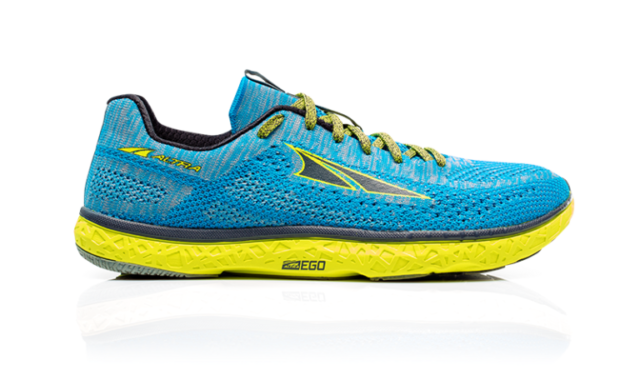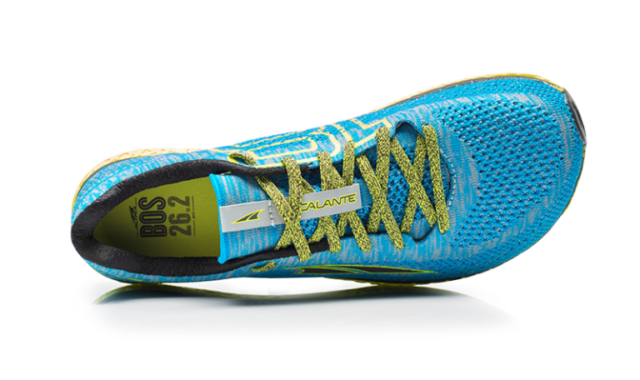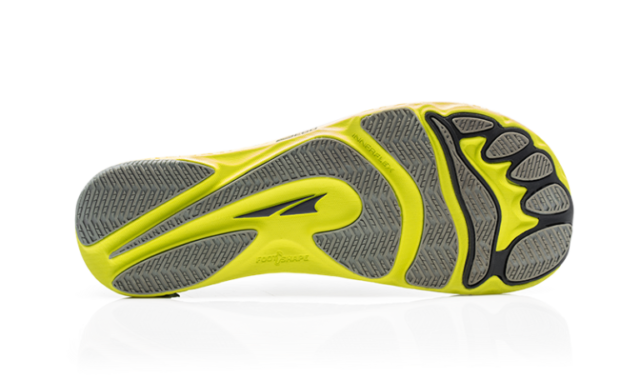
Altra Boston Escalante Racer
Stack Height: 22 (heel); 22 (toe)
Drop: 0
Stated Features:
- Insole: 5 mm Contour Footbed
- Platform: Fully Cushioned Zero Drop™ platform and FootShape™ toe box
- Midsole: Altra EGO™ with InnerFlex™
- Outsole: FootPod™ Technology
- Upper: Engineered Knit
- Other Features: New Altra EGO™ Midsole Compound; Engineered Knit Upper; Sock-like Upper Fit; Metatarsal Mapping, Performance Last for Fast Training and Racing
MSRP: $140
Size Tested: 10.5
Blister’s Measured Weight (size 10.5):
- Shoes + Laces (no insoles): 197 & 198 g
- Insoles: 23 & 22 g
- Total Weight: 220 & 220 g
Test Location: Santa Fe, NM
Test Duration (So Far): 15 miles
Reviewer: 5’10”, ~175 lbs. (my running background and preferences)
Intro
I reviewed the original Altra Escalante earlier this summer, and found it to be an extremely comfortable shoe that did a good job of bridging the gap between casual, everyday shoes and dedicated running shoes.
But Altra has recently added some new versions of the Escalante, including the Escalante 1.5 (which I’ll be reviewing soon), and the Boston Escalante Racer.
The Boston Escalante Racer is a limited-edition version of the Escalante that’s based on the original Escalante’s design, but features some important differences to make it faster, more efficient, and more race-ready.
I’ll be updating this review after spending more time in the Boston Escalante Racer, but after my initial time in the shoes, I can say that I’m very psyched on this version of the Escalante, so I wanted to get some initial information and impressions out now.
What Altra says about the Boston Escalante Racer
“The Boston Escalante Racer is our faster, higher performance version of the Escalante, available for a limited time. This first rendition is inspired by Boston and available in an eye-catching blue and yellow colorway with a large “18” on the side, perfect for celebrating your 2018 Boston memories. The upper is firmer, more breathable and has a lighter heel counter for optimum cornering and comfort on the race course. To top it off, the Altra EGO™ midsole is a touch firmer for better energy return and a little less cushion. Altra will release several limited edition Escalante Racers inspired by races in major cities across the globe.”
I’d like to buy a beer for whoever it was at Altra who wrote this product copy, because I think it’s quite on point. And the key points here are (1) its upper is firmer and more breathable than the original Escalante, (2) it has a lighter heel counter, and (3) its midsole is firmer. So if you were trying to make a “faster, higher performance version of the Escalante,” I think these changes all make good sense.
Zero Drop
The Boston Escalante Racer features a lower stack height of 22 mm (compared to the Escalante’s 25 mm and Escalante 1.5’s 24 mm), but the Boston Escalante Racer still has no drop from the heel to the toe.
So as with any zero-drop shoe, it’s important to keep in mind that the Boston Escalante Racer will require a transition period to adapt to the forefoot-striking style it encourages if you’re coming from shoes with more traditional heel-to-toe drops (e.g., 8-12 mm). We recommend checking out Altra’s Transition Plan for more info on this.
Fit
There’s no big change here per se — but I’ll quickly add the caveat that you should read our next section about the shoe’s upper.
The Boston Escalante Racer fits very similarly to the original Escalante, so I’d recommend checking out that review for a more detailed description of the fit. But the short version is that the Boston Escalante Racer feels fairly wide, particularly in the toe box. And while the last and shape of the Boston Escalante Racer aren’t different from the Escalante, the Boston Escalante Racer’s new upper does have an impact on how the shoe feels.
Upper
This is one of the major changes with the Boston Escalante Racer compared to both the original Escalante and Escalante 1.5. The Boston Escalante Racer features an upper with a much more open knit structure throughout most of the shoe. Altra says this new upper is more breathable, and despite the original Escalante’s upper being pretty breathable to begin with, the Boston Escalante Racer’s upper takes this to a new level.
But Altra says the Boston Escalante Racer’s upper is also a bit firmer. And given this shoe’s intentions (i.e., to be a faster, more race-oriented version of the Escalante), I think that makes sense. Because the original Escalante’s upper is very stretchy and supple. And while that makes the shoe extremely comfortable and work very well for things like just hanging around, it also meant that the Escalante offered very little lateral support (which, to be clear, I was 100% okay with).

But for a shoe that’s supposed to be a tuned-up, more performance-oriented version of the Escalante, I’m fine with Altra choosing to go with a firmer and less stretchy upper on the Boston Escalante Racer. Again, I still love the stretchy upper of the original Escalante, but if I was running 26.2 miles in warm weather, I’d probably really appreciate the breezy nature of the Boston’s upper. And given that the holes are pretty large on the upper of the Escalante Racer, I imagine that the stiffer material might make that upper a bit more durable and less prone to rip or tear. Of course, I’ll be reporting back after I get more miles in the shoe.
Midsole
This is the other major change for the Boston Escalante Racer, and the one I personally am the most excited about.
The original Escalante had a very soft, spongy midsole that I said felt like a mountain bike fork that had very plush suspension, but that also blew through its travel on big impacts. The Escalante’s midsole just felt a bit too soft and insubstantial for my liking.
So in comes the Boston Escalante Racer, which Altra says has a firmer version of the Escalante’s “Altra EGO” midsole. This is another update on the Boston Escalante Racer that I think makes a lot of sense. While the Escalante’s midsole was comfortable, on most runs I would’ve preferred something that felt a bit more efficient and less mushy.
And while I’ve only gone on a few runs in the Boston Escalante Racer, my initial impressions are very positive — this newer midsole feels great. Similar to the Escalante, but with a firmer ride that seems to just make more sense for a dedicated running shoe (whereas the original Escalante is marketed as a shoe that you can run in, wear around town, take to the gym, etc.).
I’ll be putting a lot more miles on the Boston Escalante Racer, but so far, I really like the new midsole.
Outsole
No changes here. The Boston Escalante Racer features the same “Foot Pod” outsole as the Escalante and Escalante 1.5, which has rubber covering pretty much all the contact areas and features a few grooves to allow the shoe to the flex around the forefoot and heel.

Weight & Comparisons
The Boston Escalante Racer shaves around 30 grams off the Escalante and Escalante 1.5, with the Boston Escalante Racer coming in at a very light 220 grams per shoe in a size 10.5. Again, this is a racing-oriented shoe, and the Boston Escalante Racer’s lower weight seems like another sensible upgrade to reflect that design intention.
For reference, here are a few of our measured weights (per shoe, in grams) for some relevant shoes.
142 & 143 Altra Vanish-R, size 10.5 (with thicker insoles)
220 & 220 Altra Boston Escalante Racer, size 10.5
229 & 229 Altra Solstice, size 10.5
248 & 253 Altra Escalante 1.5, size 10.5
252 & 253 Altra Escalante, size 10.5
253 & 263 Hoka Hupana, size 10.5
268 & 268 Brooks PureFlow 7, size 10.5
Questions / Things We’re Curious About
(1) As a higher-performance shoe that bears the name of one of the most famous marathons out there, how viable will the Boston Escalante Racer be as an everyday running shoe? Or should people think about this shoe solely as the one you grab when trying to set a PR?
(2) I put over 500 miles in the Escalante; will the Escalante Racer be similarly durable, or far more delicate?
(3) I’m already pretty psyched about the Boston Escalante Racer’s firmer midsole for running, but will the new shoe still preserve the comfortable versatility of the original Escalante? In other words, will I still want to use the Boston Escalante when I’m not running?
(4) Just how noticeable is the Boston Escalante’s more airy upper when running in hot weather?
(5) Who should still opt for the Escalante or Escalante 1.5 over the Boston Escalante Racer?
Bottom Line (For Now)
Altra says the Boston Escalante Racer is a higher-performance version of their original Escalante, and based on my limited time so far, all the updates seem to match up with that description. I’ll be putting more miles on the Boston Escalante Racer, and will update this review after comparing it to some other shoes to see where, exactly, the Boston Escalante Racer fits into the larger running shoe market, and within Altra’s own lineup.

I’d love to know if the shape of the Boston Escalante racer has the ORIGINAL shape foot or the STANDARD one. I cannot find this information anywhere…maybe you can help me?
thank you!!!